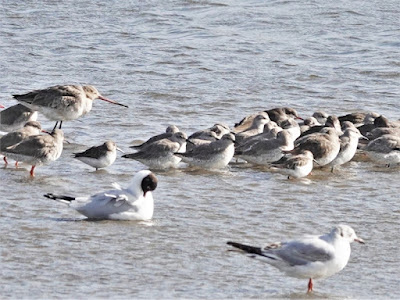A beautiful Spring morning looking over the marsh alongside the distant (invisible) River Dee. Only a few mostly dead aircraft vapour trails to spoil the blue sky.
A quintet of Shelduck. The bird with its bill at the front of the group is a first-year bird with a less-colourful bill and pale around the bill base. The others, all with quite large red swellings at the base of their bills, would appear to be all drakes. Ducks would also show the narrower chestnut breast band of the first-year.
Oystercatchers are noisy birds when nesting. Probably a pair here.
They are quite comical when they march along, head-down, bills agape as they declaim their territory.
All the noise does not seem to affect the Black-headed Gulls.
Several species of wader here. Back left with the long bill is a Black-tailed Godwit. Around its rear are three Redshank. The smaller wader behind the adult Black-headed Gull is a Dunlin. In front of it, slightly larger and with black bills, is a group of Knots with a Redshank at the back and with another Dunlin in the front.
A few of the Dunlin are just beginning to acquire a few specks of black in their belly as they come in to breeding plumage when the whole belly will be black. The back with go a mix of browns and they will look like a totally different species.
A small lake at the back of Morrison's in New Brighton has a pontoon which despite all the people around attracts waders to roost at high tide. There are four Redshank at the back. All the rest are Turnstones. This species also changes colour in the breeding season with a mix of oranges and browns. A few such feathers area visible, the easiest to spot is in the centre of the second row as we look at the mass of birds.
All the waders in this view are Black-tailed Godwits. They acquire the rufous tones in the breeding season with younger birds being less rufous. A first year Black-headed Gull is in the foreground.
This Black-tailed Godwit is in transition to summer plumage with grey feathers in the wing still to be moulted.
In goes the bill. Note it is using its feet to stir the mud up to dislodge prey items.
Success! Lunch.
Time for a siesta?
No: here it is again feeding in the grass this time.
No sign of breeding plumage in this bird.
Two more. Note the one nearest us is moulting its wing feathers exposing the white area above the black tail of its name.
A typical view of feeding Black-tailed Godwits, wading up to their belly and using their long bill to probe the mud.
They do come up for air! None of these has started to acquire breeding plumage. At this date they may be immatures who will stay like this all Summer.
This brute of an adult Herring Gull was photographed in West Kirby Marine Lake. A raised footpath around the lake is walkable except in the very highest of tides. From a distance on any normal high tide pedestrians look to be walking on water.
Flying up the River Mersey off New Brighton is a Cormorant in full breeding plumage. All the birds around Priorslee at the moment are immatures, the adults having moved to their breeding trees at larger lakes.
(Ed Wilson)





















